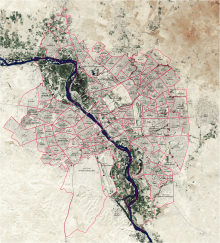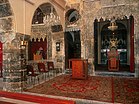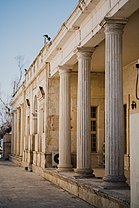
Back Mosoel Afrikaans Mosul ANG الموصل Arabic ܡܘܨܠ ARC الموصل ARZ Mosul AST Mosul Azerbaijani موصول AZB Мосул Bashkir Масул Byelorussian
Mosul
الموصل | |
|---|---|
Top to bottom, left to right: View over Tigris river Church of Saint Thomas • Hatra Mosul Rural area • The river's gate Mosul Museum • Heritage house | |
| Nickname(s): Nīnwē ܢܝ݂ܢܘܹܐ The Pearl of the North | |
| Coordinates: 36°20′N 43°08′E / 36.34°N 43.13°E | |
| Country | |
| Governorate | Nineveh |
| District | Mosul |
| Area | |
| • Total | 180 km2 (70 sq mi) |
| Elevation | 223 m (732 ft) |
| Population (2023) | |
| • Total | 1,792,000 |
| Macrotrends[2] | |
| Demonym(s) | Mosuli Maslawi |
| Time zone | UTC+3 (AST) |
| Area code | 60 |




Mosul (/ˈmoʊsəl, moʊˈsuːl/ MOH-səl, moh-SOOL; Arabic: الموصل, romanized: al-Mawṣil, pronounced [alˈmawsˤil] ⓘ, locally [ɪlˈmoːsˤɪl]; Kurdish: مووسڵ, romanized: Mûsil;[3][4] Turkish: Musul; Syriac: ܡܘܨܠ, romanized: Māwṣil[5]) is a major city in northern Iraq, serving as the capital of Nineveh Governorate.[6] The city is considered the second-largest city in Iraq in terms of population and area after the capital Baghdad. Mosul is approximately 400 km (250 mi) north of Baghdad on the Tigris river. The Mosul metropolitan area has grown from the old city on the western side to encompass substantial areas on both the "Left Bank" (east side) and the "Right Bank" (west side), as locals call the two riverbanks. Mosul encloses the ruins of the ancient Assyrian city of Nineveh – once the largest city in the world – on its east side.
Mosul is considered among the larger and more historically and culturally significant cities of the Arab world. Due to Mosul's strategic location, it has traditionally served as a hub of international commerce and travel. The North Mesopotamian dialect of Arabic, commonly known as Moslawi, is named after Mosul and is widely spoken in the region. Together with the nearby Nineveh Plains, Mosul is one of the historical centers of the Assyrian people.[7]
Mosul and its surroundings have an ethnically and religiously diverse population; a large majority of its population are Arabs, with Assyrians, Turkmens, Kurds and other minorities comprising the rest of the city's population. Sunni Islam is the largest religion, but there are a significant number of Christians, as well as adherents of other sects of Islam and other minority religions.
Historically, essential products of the area include Mosul marble and oil. Mosul is home to the University of Mosul and its renowned Medical College, one of the Middle East's largest educational and research centers.
- ^ Gladstone, Philip (10 February 2014). "Synop Information for ORBM (40608) in Mosul, Iraq". Weather Quality Reporter. Retrieved 16 June 2014.
- ^ "Mosul, Iraq Metro Area Population 1950-2023". Macrotrends.
- ^ "Nêçîrvan Barzanî: Serxwebûn Mafê Gelê Kurd E" (in Kurdish). Voice of America. Retrieved 13 March 2020.
- ^ "ئەمساڵ كۆنسۆڵخانەى توركيا لە مووسڵ دووبارە دەكرێتەوە" (in Kurdish). Anadolu Agency. Retrieved 13 March 2020.
- ^ Thomas A. Carlson et al., "Mosul — ܡܘܨܠ " in The Syriac Gazetteer last modified June 30, 2014, http://syriaca.org/place/139.
- ^ Coker, Margaret (2017-12-10). "After Fall of ISIS, Iraq's Second-Largest City Picks Up the Pieces". The New York Times. ISSN 0362-4331. Retrieved 2021-04-25.
- ^ Dalley, Stephanie (1993). "Nineveh After 612 BC." Alt-Orientanlische Forshchungen 20. p.134.
© MMXXIII Rich X Search. We shall prevail. All rights reserved. Rich X Search








